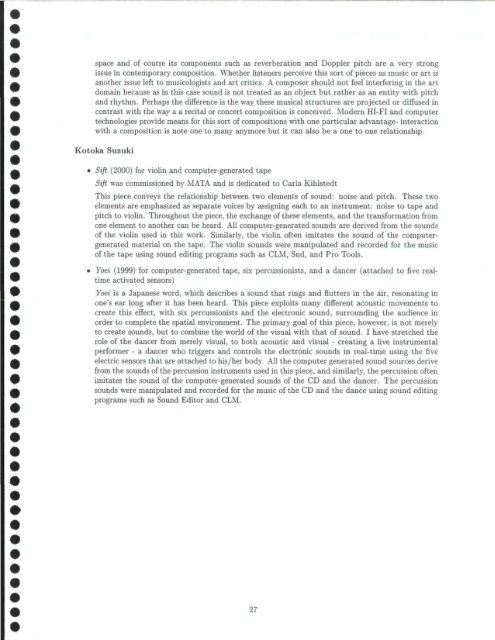CCRMA OVERVIEW - CCRMA - Stanford University
CCRMA OVERVIEW - CCRMA - Stanford University
CCRMA OVERVIEW - CCRMA - Stanford University
You also want an ePaper? Increase the reach of your titles
YUMPU automatically turns print PDFs into web optimized ePapers that Google loves.
space and of course its components such as reverberation and Doppler pitch are a very strong<br />
issue in contemporary composition. Whether listeners perceive this sort of pieces as music or art is<br />
another issue left to musicologists and art critics. A composer should not feel interfering in the art<br />
domain because as in this case sound is not treated as an object but rather as an entity with pitch<br />
and rhythm. Perhaps the difference is the way these musical structures are projected or diffused in<br />
contrast with the way a a recital or concert composition is conceived. Modern HI-FI and computer<br />
technologies provide means for this sort of compositions with one particular advantage- interaction<br />
with a composition is note one to many anymore but it can also be a one to one relationship.<br />
Kotoka Suzuki<br />
• Sift (2000) for violin and computer-generated tape<br />
Sift was commissioned by MATA and is dedicated to Carla Kihlstedt<br />
This piece conveys the relationship between two elements of sound: noise and pitch. These two<br />
elements are emphasized as separate voices by assigning each to an instrument: noise to tape and<br />
pitch to violin. Throughout the piece, the exchange of these elements, and the transformation from<br />
one element to another can be heard. All computer-generated sounds are derived from the sounds<br />
of the violin used in this work. Similarly, the violin often imitates the sound of the computergenerated<br />
material on the tape. The violin sounds were manipulated and recorded for the music<br />
of the tape using sound editing programs such as CLM, Snd, and Pro Tools.<br />
• Yoei (1999) for computer-generated tape, six percussionists, and a dancer (attached to five realtime<br />
activated sensors)<br />
Yoei is a Japanese word, which describes a sound that rings and flutters in the air, resonating in<br />
one's ear long after it has been heard. This piece exploits many different acoustic movements to<br />
create this effect, with six percussionists and the electronic sound, surrounding the audience in<br />
order to complete the spatial environment. The primary goal of this piece, however, is not merely<br />
to create sounds, but to combine the world of the visual with that of sound. I have stretched the<br />
role of the dancer from merely visual, to both acoustic and visual - creating a live instrumental<br />
performer - a dancer who triggers and controls the electronic sounds in real-time using the five<br />
electric sensors that are attached to his/her body. All the computer generated sound sources derive<br />
from the sounds of the percussion instruments used in this piece, and similarly, the percussion often<br />
imitates the sound of the computer-generated sounds of the CD and the dancer. The percussion<br />
sounds were manipulated and recorded for the music of the CD and the dance using sound editing<br />
programs such as Sound Editor and CLM.<br />
27

















